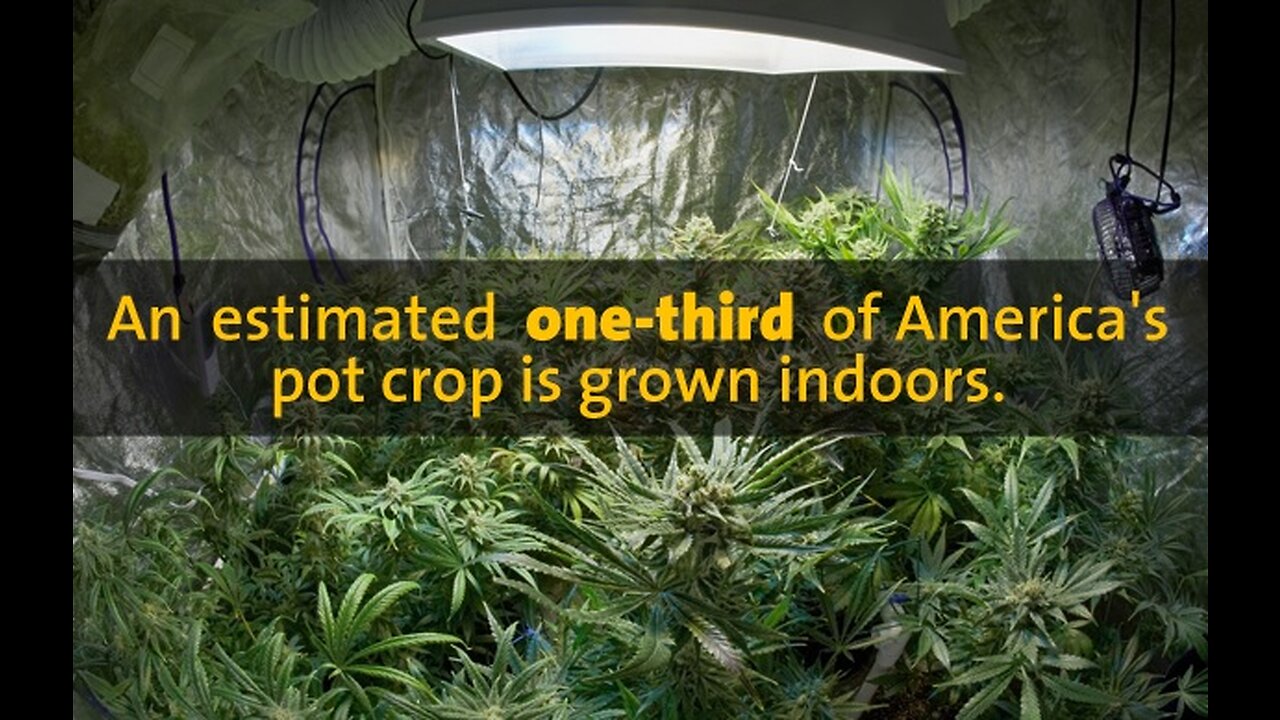Premium Only Content

True Story How US Government Tried To Kill Weed Smokers With A Toxic Chemical !
Paraquat Pot The True Story Of How The US Government Tried To Kill Weed Smokers With A Toxic Chemical When people talk about “killer weed,” that’s typically understood to mean really good weed. But due to US government policies that started in the 1970s and extended through most of the 1980s, marijuana fields were being sprayed with a chemical that can actually kill you.
The chemical, known as “paraquat,” is an herbicide sprayed over marijuana fields in Mexico in the 1970s—with the aid of US money and US-provided helicopters—and over marijuana fields in Georgia in the 1980s under the direction of the Reagan Administration. But normally, anything poisonous enough to kill plants is also toxic enough to kill humans, and that is the case with paraquat.
Paraquat is an organic acid that is used as an herbicide. It kills green plant tissue on contact.
• When sprayed on plants, paraquat is tasteless and odorless and invisible. In other words, you wouldn’t be able to tell if the weed you were smoking had been sprayed with paraquat.
• As far as breathable poisons go, the government has placed paraquat in Toxicity Category I—the highest possible level.
• Due to the fact that it is cheap and available, liquid paraquat is frequently used in suicides throughout much of the Third World.
• In humans, exposure to paraquat has been linked to the development of Parkin’s disease.
• Depending on the dose and the method of ingestion, paraquat can either be immediately fatal or can lead to kidney, liver, lung, and heart failure for up to 30 days after exposure.
• Tests performed in 1977 demonstrated that combusted paraquat caused damage to the lungs of laboratory rats.
• In 1978, after years of attempting to reassure Americans that smoking paraquat-tainted marijuana was safe, US Secretary of Health Education and Welfare Joseph Califano announced that new tests found that heavy smokers of tainted weed could develop irreversible lung damage and that even moderate users could develop “clinically measurable damage.”
1970s: Paraquat Pot From Mexico Comes To The USA
In 1969, the Nixon White House made marijuana eradication a top priority. Rather than attempting to stop the flow of drugs in through the border, scientists began looking for a way to directly contaminate the marijuana itself. They originally developed a spray that was intended to make users nauseous, but this was shelved.
In 1975, as part of “Operation Clearview,” the Nixon Administration started supplying Mexico with about $15 million annually in aid that included helicopters designed to spray marijuana and poppy fields with herbicides.
Officials had recommended spraying marijuana fields with herbicides—their stated intent was to kill the drug at its source by spraying the fields. But in deeply impoverished Mexico, where in the 1970s harvesting marijuana could make the difference between a yearly income of $200 and one of $5,000, many growers simply harvested the poisoned marijuana and shipped it north anyway.
According to one report, an American helicopter pilot was getting high on prime Oaxacan weed while he was spraying fields below him with paraquat.
According to one study in 1978, 13 percent of marijuana samples texted in the southwestern USA were contaminated with paraquat. Other tests found that anywhere from 20 to 30 percent of the marijuana that had made its way into the US from Mexico was paraquat-tainted. Some samples contained concentrations of paraquat that were 40,000 times higher than the recommended domestic use.
This led to a public panic, seeing as how marijuana may have been even more popular in the 1970s than it is now. Fly-by-night businesses made a killing by offering to test if your marijuana had been sprayed with paraquat. A running joke among stoner comedians was that they would welcome if you’d send them your marijuana to sample for paraquat.
To circumvent the national outrage—which observers noted had been the first time that American students were really pissed off about something since the early 1970s—the government began rolling out plans to at least make paraquat pot detectable to the senses. There were suggestions about releasing a red dye along with the paraquat. Then there were plans to also use an extract of orange peel in the paraquat spray, which the State Department explained would give pot smokers ““the foulest‐smelling joint or brownie they ever had.”
It took a 1978 lawsuit from the National Organization to Reform Marijuana Laws to force the US Government to suspend funding for paraquat-spraying in Mexico until a comprehensive health study of its effects could be performed.
1980s: Reagan Administration Sprays Crops in Georgia
A scandal erupted in the state of Georgia in 1983 when it was uncovered that law enforcement officials had aided in smuggling drugs from south of the border into the USA. They had also facilitated the planting and cultivation of giant weed farms in Georgia’s Chattahoochee Forest.
In retaliation, the Reagan Administration ordered US helicopters to spray these weed plantations with paraquat and the DEA vowed to extend the practice to wherever weed was being grown in the USA.
For many, purposely damaging the lungs of pot smokers—perhaps fatally—was a punishment that far exceeded the crime. One critic likened the practice to placing land mines in NO PARKING zones.
Luckily, the practiced was quickly banned due to lawsuits filed based on environmental concerns.
Then in 1988, the DEA announced that it would resume spraying marijuana fields with the deadly substance.
The feds terminated this practice in the 1990s but paraquat remains one of the most commonly used herbicides on the market.
These days it is generally agreed that marijuana use is generally safe. In hindsight, the paraquat scare of the 1970s and 1980s seems like a case of “Reefer Madness” gone wild. It is unknown how many Americans were disabled or even killed by this sick and hysterical government policy. It is bitterly ironic that the same government which had for decades tried to insist that marijuana was bad for you had finally found a way to make it bad for you.
With pop culture influences like Pink Floyd, The Grateful Dead, and Led Zeppelin, the 1970s ushered in a new perspective on drugs. From rock-n-roll to disco, Cheech & Chong to Hunter S. Thompson, the 70s, anti-establishment counterculture helped shape the history of marijuana as we know it. As hippies faded into the sixties, Nixon started the infamous "War on Drugs," and a new era of marijuana subculture began.
During the 1970s, troops returned from the Vietnam war, and cannabis strains from around the world started cropping up (pun intended), in the U.S. black market. As cannabis breeders and consumers pushed for stronger weed, selective breeding and cross-breeding for decades changed cannabis over the years. Many of these classic, old-school 1970’s marijuana strains are rare, but some are still available at your local dispensary, albeit likely quite a bit stronger than you remember.
So, queue up your 70s playlist, pull up a bean bag, and turn on a lava lamp, then let's take a walk down memory lane and review a few of the most popular 1970’s marijuana strains from four decades ago, their origins, and how they helped shape the future of the cannabis industry
Before the discovery of hydroponics, selective breeding, and advanced growing techniques, marijuana strains were not the powerful, potent strains of today. Supporting this theory, recent reports show 1970’s marijuana strains averaged between 1-4 percent, while the average THC content in strains today is around 13 percent with some of the most potent strains reaching between 25 and 30 percent.
On the other hand, others believe there's no accurate way to make that comparison. Opponents claim many of the high-potency, premium cannabis strains, and products of the 70s were ignored or went untested in many cases, thus making any test averages inaccurate. Many of the common 1970’s marijuana strains likely produced just as much THC then as they do today.
Like ancestry and genetics paint a picture of our biological origins, as cannabis products, strains, and even consumers continue to evolve, we mustn't lose sight of our roots. These classic 1970’s marijuana strains, along with a few talented breeders, contributed to the wide variety of strains and products available in legal markets across the nation. Without a doubt, we can thank this psychedelic decade for planting the seeds which grew into the cannabis industry we know and love today.
-
 6:16
6:16
What If Everything You Were Taught Was A Lie?
24 days agoI Was Born With Male And Female Parts "Congenital Adrenal Hyperplasia" Female External Genitalia
3.44K3 -
 1:37:05
1:37:05
AlaskanBallistics
2 hours ago $0.08 earnedI Love This Gun PodCast #16
6.89K3 -
 2:59:26
2:59:26
Twins Pod
11 hours agoEMERGENCY PODCAST WITH ANDREW TATE! - Twins Pod - Special Episode - Andrew Tate
128K132 -
 2:52:01
2:52:01
Jewels Jones Live ®
2 days agoTRUMP SECURES BORDER | A Political Rendezvous - Ep. 113
62K30 -
 25:02
25:02
marcushouse
1 day ago $4.85 earnedStarship Just Exploded 💥 What Went Wrong This Time?!
140K66 -
 12:00
12:00
Silver Dragons
1 day agoBullion Dealer Reveals Best Silver to Buy With $1,000
85.1K9 -
 12:58
12:58
NinjaGamblers
14 hours ago $2.21 earnedIs This The BEST Way to Win At Roulette? 😲
129K13 -
 1:01:54
1:01:54
CharLee Simons Presents Do Not Talk
2 days agoCALIFORNIA'S DONE!
87.4K38 -
 7:33
7:33
MudandMunitions
1 day agoUnboxing My FIRST Revolver! Smith & Wesson 442 .38 Special and What’s Coming Next for the Channel
117K16 -
 1:01:05
1:01:05
Trumpet Daily
1 day ago $4.85 earnedGermany Started Two World Wars and Now Wants Nuclear Weapons - Trumpet Daily | Mar. 7, 2025
93.6K90